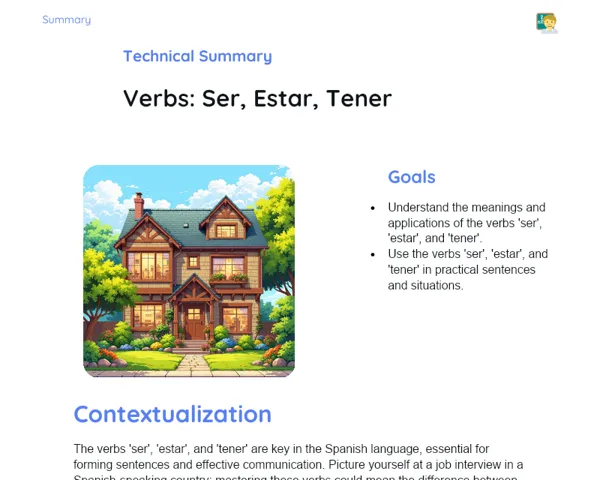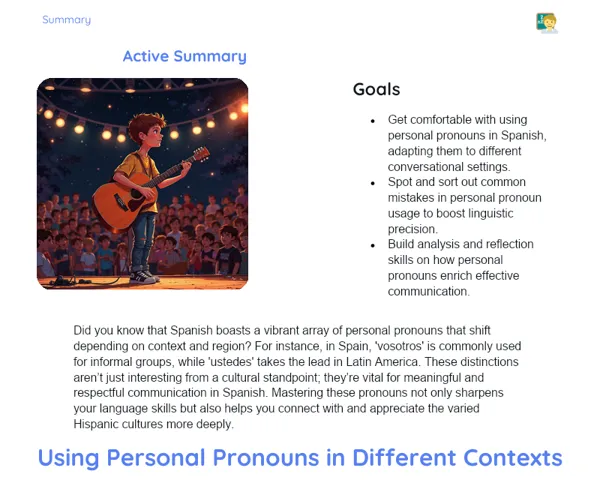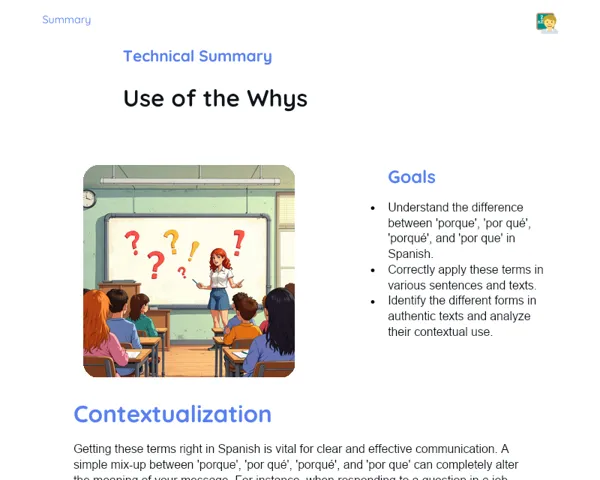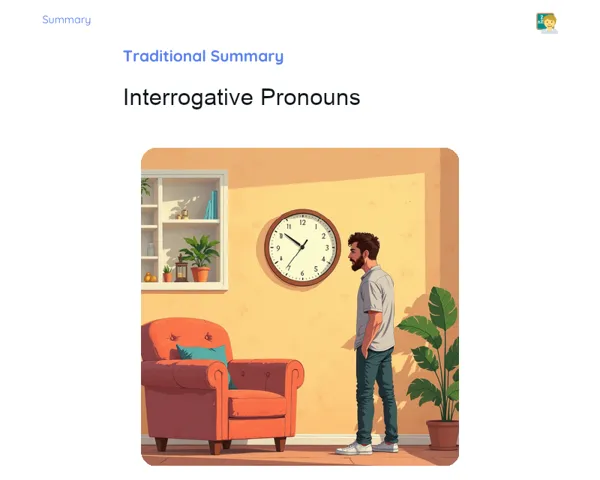Summary Tradisional | Verbs: Tense Problems
Contextualization
Understanding verb tenses is a cornerstone of grammar in any language, including Spanish. They help us pinpoint actions and events in time, showing whether something is happening now, has happened in the past, or will take place in the future. Grasping and correctly using verb tenses is crucial for effective communication, both in writing and speaking.
In Spanish, verb tenses are vital for clarity and precision in our messages. For instance, when we say 'Yo comí' (I ate), we're indicating that the action of eating has been completed in the past. Conversely, when we say 'Yo comeré' (I will eat), we let someone know that the action is set to happen. This distinction is important to avoid misunderstandings and ensure the listener fully grasps our intent.
Consequently, studying the various verb tenses goes beyond simply memorising grammar rules; it enhances our ability to articulate ideas clearly and effectively. Mastering these tenses in Spanish will empower you to communicate more accurately and deepen your understanding of the texts you encounter.
To Remember!
Present Indicative
The Present Indicative is used to describe actions happening right now, recurring actions, and universal truths. For example, 'Yo hablo' (I speak) indicates an action taking place at this moment. This tense is fundamental for expressing real-time actions and discussing routines, like 'Yo desayuno todas las mañanas' (I have breakfast every morning).
Besides capturing habitual actions, the Present Indicative can express universal truths or facts that are always correct, such as 'El sol sale por el este' (The sun rises in the east). This use is key for communicating generally accepted knowledge clearly and effectively.
Additionally, this tense can project near-future actions, especially when paired with time expressions hinting at the future, such as 'Mañana viajo a Madrid' (Tomorrow I will travel to Madrid). Hence, the Present Indicative is a versatile tense that applies to a wide range of situations in Spanish.
-
Describes actions at the moment of speaking.
-
Used for habits and routines.
-
Can express universal truths and near-future actions.
Preterite Perfect
The Preterite Perfect describes actions that have been completed in the past. For example, 'Yo comí' (I ate) illustrates that the action was finalised at a specific time in the past. This tense is essential for narrating past events in a clear and accurate manner, providing a precise timeline for the described actions.
Moreover, the Preterite Perfect is useful for reporting a series of events that took place during a specific period, like in 'Ayer llegué a casa, cené y me fui a dormir' (Yesterday I got home, had dinner, and went to sleep). Using this tense allows us to organise events chronologically, which aids listener or reader comprehension.
This tense is also applied when the past action doesn't connect directly to the present. For example, 'El año pasado viajé a México' (Last year I travelled to Mexico). The traveling was a past action and is not directly tied to the present.
-
Describes completed actions in the past.
-
Used to report sequences of past events.
-
Past action without a direct connection to the present.
Imperfect Preterite
The Imperfect Preterite is utilised for describing habitual or ongoing actions that took place in the past. For example, 'Yo comía' (I was eating) conveys that the action of eating was a repeated or habitual event in the past. This tense is crucial for detailing past routines and habits, offering a richer context of past events.
Furthermore, the Imperfect Preterite allows us to recount scenes and states of being from the past, such as 'Cuando era niño, jugaba en el parque' (When I was a child, I played in the park). This enhances the vividness and detail of our recollections, enabling listeners or readers to better envision the situations described.
This tense also applies to actions that were ongoing in the past and might have been interrupted by another event, like 'Yo leía cuando él entró' (I was reading when he entered). Therefore, the Imperfect Preterite is vital for depicting continuous actions and past scenarios.
-
Describes habitual or ongoing actions in the past.
-
Used to describe scenes and states of being in the past.
-
Actions in progress in the past interrupted by another action.
Future Indicative
The Future Indicative is employed for discussing actions that are set to occur. For example, 'Yo comeré' (I will eat) indicates that the eating action will take place in the future. This tense is key for articulating plans, predictions, and future intentions with clarity.
In addition to denoting future actions, the Future Indicative can express assumptions or predictions about the present, particularly when uncertainty exists, such as in '¿Qué hora será?' (What time will it be?). This helps convey hypotheses and conjectures in a formal manner.
This tense is also used for giving commands or formal instructions, like 'Llamarás a tus padres cuando llegues' (You will call your parents when you arrive). Thus, the Future Indicative is a flexible verb tense applicable in a variety of future communication contexts.
-
Describes actions that will occur in the future.
-
Used to make assumptions or conjectures about the present.
-
Used to give commands or formal instructions.
Key Terms
-
Present Indicative: Verb tense describing habitual actions, universal truths, and present actions.
-
Preterite Perfect: Verb tense used to depict actions completed in the past.
-
Imperfect Preterite: Verb tense describing habitual or continuous actions that occurred in the past.
-
Future Indicative: Verb tense used for actions expected to take place in the future.
Important Conclusions
During this session, we examined the significance of verb tenses in the Spanish language and explored how each contributes to clear and precise communication. We delved into the Present Indicative, Preterite Perfect, Imperfect Preterite, and Future Indicative, gaining insights into their practical uses and differences. Understanding these verb tenses equips us to locate actions temporally, reducing misunderstandings and promoting effective interaction.
The knowledge gained regarding verb tenses is vital not just for writing but also for speaking and interpreting Spanish texts. Mastering these tenses enables us to create coherent narratives and enhances our comprehension of the information we absorb. Precision in using verb tenses is essential for conveying ideas clearly and effectively.
I encourage everyone to keep exploring and practising the use of verb tenses across different contexts. The more familiar we are with these structures, the more naturally we can communicate in Spanish. Remember, consistent practice is the key to mastering any aspect of language.
Study Tips
-
Practice conjugating verbs in various tenses, crafting sentences and short stories for each.
-
Read Spanish texts, like news articles, stories, and essays, while identifying and examining verb tense usage.
-
Engage in translation exercises between Portuguese and Spanish, paying close attention to verb tenses.



